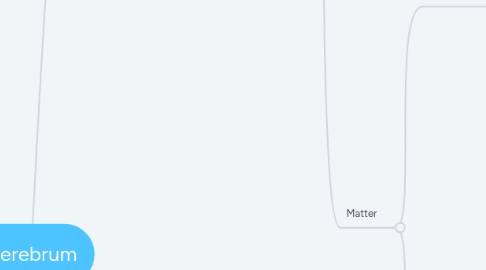
1. 2 hemispheres
1.1. separated by Longitudinal Fissure (partially), in front & back (complete)
1.2. connected by Corpus Callosum
1.3. Lobes
1.3.1. 4 superficial
1.3.1.1. Frontal
1.3.1.2. Parietal
1.3.1.3. Temporal
1.3.1.4. Occipital
1.3.2. 2 central
1.3.2.1. Insula (hidden-seen by seperating 2 lips of lateral sulcus)
1.3.2.2. Limbic lobes (seen on medial surface)
1.4. 3 Poles
1.4.1. Frontal
1.4.2. Temporal
1.4.3. Occipital
1.5. 3 Surfaces
1.5.1. Supero-lateral
1.5.1.1. Lobes
1.5.1.1.1. Frontal
1.5.1.1.2. Parietal
1.5.1.1.3. Temporal
1.5.1.1.4. Occipital
1.5.2. Medial
1.5.2.1. parieto-occipital sulcus
1.5.2.1.1. seperates
1.5.2.2. Corpus Callosum (prominent)
1.5.2.2.1. Septum pellucidum attached under its surface
1.5.2.2.2. Parts (ant. to post.)
1.5.2.2.3. Seperated from
1.5.2.3. each side of central sulcus above cingulated sulcus
1.5.2.3.1. paracentral lobules( Areas 4 & 3,1,2
1.5.3. Inferior
1.5.3.1. smaller, ant portion represent orbital surace of frntal lobe
1.5.3.1.1. rectus sulcus
1.5.3.2. larger portion represent inf. surface of temporal & occipital lobes
1.5.3.2.1. transversed by 2 anterior-posterior sulci
1.6. 3 Borders
1.6.1. Superior
1.6.2. Inferior-lateral
1.6.3. Infero-medial
1.7. Matter
1.7.1. Outer Gray Matter
1.7.1.1. CORTEX
1.7.1.1.1. Gyri (elevations)
1.7.1.1.2. Sulci (grooves)
1.7.2. Inner White Matter
1.7.2.1. embedded deep nuclear masses ( basal ganglia & diencephalon)
1.7.2.2. Commiissures
1.7.2.2.1. connect corresponding gyri of 2 hemisperes
1.7.2.3. Projection tracts (Fibers)
1.7.2.3.1. connect more or less vertically
1.7.2.4. Assc. tracts (fibers)
1.7.2.4.1. Connect one gyrus to another in same hemisphere

